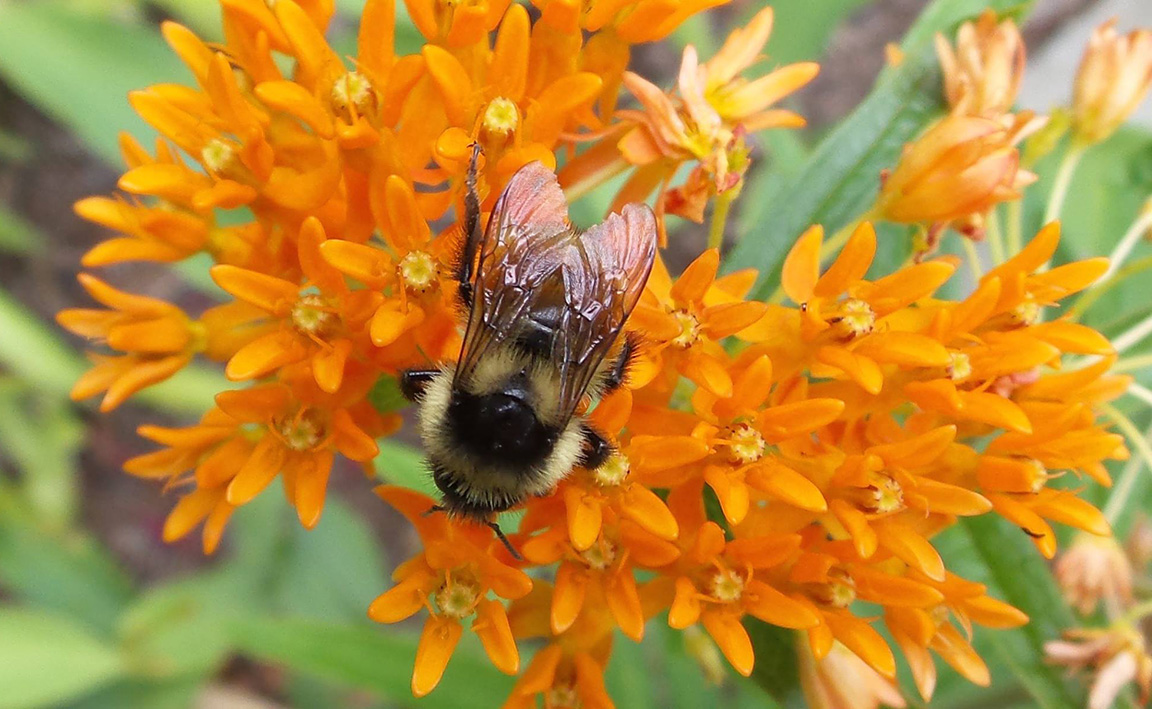
Maine Home Garden News — August 2018
- August Is the Month to . . .
- Now Is a Great Time to Take Stem Cuttings
- Anenome ‘Honorine Jobert’
- Ecotat Gardens and Arboretum
- Food & Nutrition: Preserving Tomatillos
August Is the Month to . . .
By Tori Lee Jackson, Associate Professor of Agriculture and Natural Resources, University of Maine Cooperative Extension Androscoggin and Sagadahoc Counties
- Stay ahead of sweet corn pests. Learn how to identify and prevent caterpillars from enjoying your long-awaited sweet corn crop with Bulletin #5101, Managing Insect Pests of Sweet Corn.
- Attend a workshop and learn how to extend your growing season, safely cook for crowds, make blueberry jam, and more. To see what’s happening in your area, check out the UMaine events calendar for August.
- Harvest your garlic and save some of the larger heads for replanting this fall. For more information about growing garlic, see Bulletin #2063, Growing Hardneck Garlic in Your Maine Garden. If you haven’t grown it before (or you just want to eat all you grew), you can find more information on the Maine Seed Garlic Directory.
- Fix your lawn. Have some trouble spots or interested in reseeding your entire lawn? Mid-August through September is the best time of year to establish new grass. Check out Bulletin #2367, Establishing a Home Lawn in Maine, Bulletin #2243, Maintaining a Home Lawn in Maine, and Bulletin #2166, Steps to a Low-Input, Healthy Lawn for tips and step-by-step instructions.
- Start Monitoring for Spotted Wing Drosophila (SWD) if you have summer-ripening fruits. Late season raspberries and elderberries are favorites of this invasive fruit fly. Learn how to make simple Spotted Wing Drosophila Traps. To see SWD counts in our traps, you can find weekly updates from Small Fruit and Vegetable Specialist, David Handley on this Highmoor Farm blog.
- Attend Maine’s Agricultural Fairs! August is peak fair season. Enter your famous pickles, pie, or artwork in the local fair and take in a tractor-pull or midway, too. Check out the Maine Department of Agriculture, Conservation & Forestry’s full schedule of Agricultural State Fairs. Here are your options this month:
- Jul 27 – Aug 5: Bangor State Fair
- Aug 1 – 4: Monmouth Fair
- Aug 5 – 12: Topsham Fair
- Aug 9 – 18: Skowhegan State Fair
- Aug 18 – 25: Union Fair
- Aug 23 – 24: Maine Farm Days
- Aug 23 – 26: Acton Fair
- Aug 23 – 26: Piscataquis Valley Fair
- Aug 26 – Sep 3: Windsor Fair
- Aug 30 – Sep 3: Blue Hill Fair
- Aug 31 – Sep 3: Harmony Fair
- Preserve those summer flavors for the long winter ahead. UMaine Extension has lots of resources available to help you safely preserve the fruits and vegetables you are harvesting now. Whether you’re a first-timer or an old-hand, there’s something for you on our Food Preservation site.
- Keep an eye out for invasive species. In addition to some nasty insect pests, we are also seeing an influx of invasive plants in our landscapes. (Cow parsnip, anyone?) If you see something unfamiliar or concerning, get it identified at your local UMaine Extension county office and learn how to safely eradicate it before it has a chance to spread. Plant samples or photos of plants for identification should include as much information as possible: leaf shape, how the leaves are arranged on the stem, flowers or fruits, growth habit, site conditions (sun, shade, sandy, wet, dry, etc.), and other unique characteristics. Please do not collect a physical sample if the plant is growing singly or you suspect it to be poisonous (photos only). The Maine Natural Areas Program has a list of Maine Invasive Plant Fact Sheets for reference as well.
- Keep planting vegetables like beets, beans, broccoli, cauliflower, cabbage, lettuce, spinach, turnip, and more for a fall crop. There’s a handy chart in our Master Gardener Volunteers Manual to help you plan.
- Share the fruits (and vegetables) of your labor. Learn how gardeners can donate high quality surplus produce to those who have limited access to fresh vegetables with Maine Harvest for Hunger.
Now Is a Great Time to Take Stem Cuttings
Adapted by Kate Garland, Horticulturist, UMaine Extension Penobscot County, from “Propagating Plants by Cuttings” by Missouri Botanical Garden (MOBOT), missouribotanicalgarden.org
Gardens are in full swing, plants have a lot of lush new growth, and you may have a little extra potting soil kicking around. Therefore, now is a great time to experiment with taking stem cuttings to create new plants. Stem cuttings are a fun way to propagate many of your garden favorites to enjoy indoors over the winter, save yourself a little money on purchasing plants next season, or give to others as gifts.
Propagating plants from cuttings is one of the easiest and most used methods of propagation. Many plants will root from just a section of a plant. Some plants will root in water, but cuttings will develop a better root system when rooted in a soilless potting mix. Sand or perlite can also be used, especially for cuttings that need good drainage and may rot if kept too wet. Many easy-to-root plants, such as those in the mint family (coleus, oregano, basil, etc.), will not require the use of a rooting hormone. Some plants may root very slowly or not at all without the use of a rooting hormone. Numerous books and online resources are available with information on best propagation methods for specific plants, or you can call your local Extension office to discuss your propagation project.
Here are some general tips for success:
Take cuttings from the plant
Take cuttings from a plant, such as, a begonia. For most plants, cuttings should be between 4 and 6 inches long. Don’t make your cuttings too large; they will not root well or, if rooted, will become a tall, lanky plant instead of a compact one.
Assemble the materials
- Pot(s) of pre-moistened soil-less rooting medium (potting soil, perlite, vermiculite, sand, sphagnum moss, etc.)
- Pruners or a sharp knife
- Rooting hormone
- Plastic cup
- Pencil or other object slightly wider than the stem of the cutting
- Clear plastic bag or a bell jar
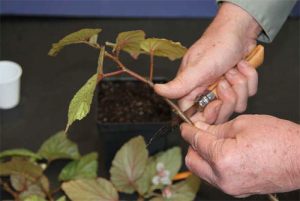
Cut stems just below a bud
Using a sharp knife (or pruners) cut just below where a leaf attaches to the stem (the node). Roots grow easiest from this location. If you leave a section of stem below the node, it often rots.
Remove lower leaves
Remove the lower leaves but leave the top two or three. Any part of the cutting that will be buried below the surface of the rooting medium should be free of leaves.

Remove any flowers that are present
Flowers are not helpful for the rooting process. If left on the cutting, the flowers will try to develop into seed and use the food reserved in the cutting that could be better used for rooting. Dying flowers will also mold and rot in the moist rooting environment. So, hard as it is, remove any flowers or buds from the cuttings.
Ready for “sticking”
Cut back to a node and stripped of lower leaves and flowers, the cutting is now ready for “sticking” into the moist rooting medium.
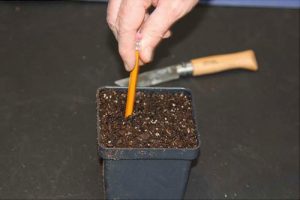
Make holes in potting mix
Use an object such as a pencil or dowel to make a hole in the potting mix. Make the hole larger than the cutting so the rooting powder (if needed) is not rubbed off when the cutting is placed in the rooting medium.
Don’t contaminate your rooting hormone
If hormone is needed, do not stick cuttings directly into the original container of rooting hormone. The moisture on the cutting will degrade the remaining hormone in the container.
Use just what you need
Pour just the amount of rooting hormone you need into a separate container, such as, a plastic cup, and reseal the original hormone container to keep it fresh.
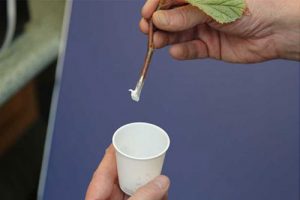
Dip the cutting
Dip the cutting in the rooting hormone and swish it around to lightly cover the bottom 1-1 ½ inches of the cutting. Tap the cutting on the side of the container lightly to remove any excess. If very little hormone powder sticks to the cutting you may want to dip the cuttings in water first, tap them to remove any excess water, and then dip them in the rooting hormone. Dispose of any excess rooting hormone in your small container. Do not put it back in the original container.
Stick cuttings into prepared holes in the rooting medium
“Stick” the cutting in the rooting medium being careful not to rub off the rooting hormone powder.
Hint: More than one cutting can be placed into a single pot. After the cuttings have rooted they can be divided and potted in separate pots. Do not crowd the cuttings, however. Crowding can result in mold and rotting.
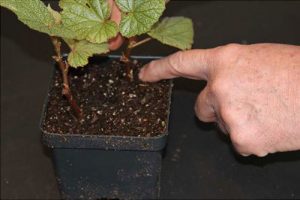
Firm soil around the cuttings
Gently press the medium around the cuttings to provide good contact between the cuttings and rooting medium.
Water
Water sparingly to also help provide good contact of the medium with the cutting and provide moisture.
Place the entire pot inside a plastic bag
To maintain humidity and moisture, place the entire pot inside a plastic bag.
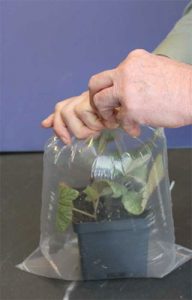
Fill the plastic bag with air
Inflate the bag to keep the sides of the bag away from the cuttings as much as possible. Leaves touching the bag are more prone to develop mold between the leaf and the bag.
Seal the plastic bag
Use a twist tie to seal the bag.
Or, use a bell jar
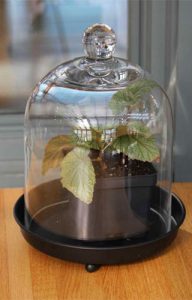
A clear glass bell jar also makes a very nice rooting chamber. It provides needed moisture but still displays the cuttings in an attractive setting. Examine the cuttings weekly to make sure the rooting medium is not drying out. When rooting has taken place (about 3 weeks for these begonia cuttings) separate the cutting and pot them in individual pots.
Rooting stem cuttings is just one of several methods of asexual propagation (i.e. producing new plants from plant parts other than seeds). Some plants are difficult to root from stem cuttings, but for many, the process is surprisingly easy. Again, many books and online resources are available to let you know what plants will propagate well from stem cuttings, but one of the best ways to learn it so simply give it a try. When you have plenty of plant material during this time of year, what do you have to lose?! Have fun!
Anenome ‘Honorine Jobert’
By Liz Stanley, Horticulture Community Education Assistant, UMaine Extension Knox and Lincoln Counties
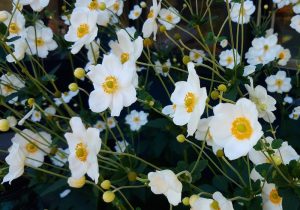
This is a plant to look forward to in late summer as it blossoms profusely into the shortening days of fall. Anenome ‘Honorine Jobert’ has elegant white flowers on tall, delicate stems, which move gracefully in the slightest breeze. Also called “Windflower,” the genus name is probably derived from the Greek word anemos, meaning wind.
‘Honorine Jobert’ is a compact Japanese anemone hybrid cultivar. It grows to 3-4′ tall and spreads gradually by underground rhizomes. Single 2-3” diameter flowers and yellow stamens appear on long, graceful, branching stems over a mound of beautiful dark green leaves. It has a long bloom period, is an attractive cut flower, and is resistant to browsing by deer. Japanese anemone cultivars are commonly sold as Anemone x hybrida or Anemone japonica. ‘Honorine Jobert’ is an old hybrid discovered in Verdun, France in 1858, synonymous with A. x hybrida ‘Alba’.
Japanese anenomes can be tricky to establish, so choose your site carefully. These hybrids prefer rich, moist, but well-drained soil that never dries out, and some shade to protect the leaves from scorching. Though known as “Windflower,” plants need protection and even some loose winter mulch in zone 4. So finding a good spot is a challenge. Plants may be slow to establish, but will naturalize well in USDA Zones 4-7. A drift of these plants against a dark background is gorgeous to behold in the low evening light of late summer.
Ecotat Gardens and Arboretum
By Julie Clark, UMaine Cooperative Extension Master Gardener Volunteer
“Stone by stone, plant by plant, a shovelful at a time, Ruth and Howard Crosby have created a living legacy from old fields gone wild.”
— Bangor Daily News, July 1996
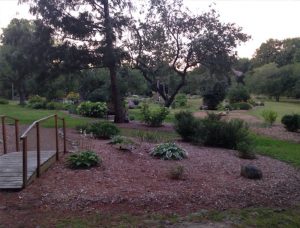 Ecotat Gardens and Arboretum, located at the intersection of Route 2 and Annis Road in Hermon, is home to abundant flowers, shrubs, trees and wildlife, the result of many years of care, nurturing and protection by Ruth and Howard Crosby. The name “Ecotat” was formed by combining portions of the words “ecological” and “habitat” to describe the land developed by the Crosbys. Approximately eight acres are home to hundreds of perennials, including daylily beds, peonies and roses, a garden bridge, a fairy garden maintained by the local Girl Scout troop, irises, flowering shrubs, and numerous other plants. The woodland trail includes well-labeled Maine native trees.
Ecotat Gardens and Arboretum, located at the intersection of Route 2 and Annis Road in Hermon, is home to abundant flowers, shrubs, trees and wildlife, the result of many years of care, nurturing and protection by Ruth and Howard Crosby. The name “Ecotat” was formed by combining portions of the words “ecological” and “habitat” to describe the land developed by the Crosbys. Approximately eight acres are home to hundreds of perennials, including daylily beds, peonies and roses, a garden bridge, a fairy garden maintained by the local Girl Scout troop, irises, flowering shrubs, and numerous other plants. The woodland trail includes well-labeled Maine native trees.
Known then as Crosby Gardens, the garden started in 1980 when Howard retired and he and Ruth developed their labor of love by clearing old fields, planting trees, and starting flower beds. They welcomed passers-by and, as more and more visitors enjoyed the gardens and woodland trails, they felt it was important for the land to be preserved as one parcel. With the blessing of their children, they took the necessary steps to establish an irrevocable land trust, and Ecotat Trust, a non-profit organization, was formed in March 1995 in order to preserve the gardens and woodlands donated by the Crosby family. It was deeded in three parcels, the first 51 acres of “old woods” in 1995, then 38 acres of established gardens in 1997, and the third parcel in 2001, which consisted of the remaining two acres and their home, now known as the Crosby house. The trustees and volunteers continue their work to improve and expand the gardens and trails and open this nature preserve to the surrounding communities and visitors.
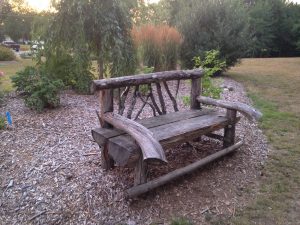 Currently, there are five Master Gardener volunteers who actively volunteer at the garden on Wednesdays. In addition to working in the gardens, three Master Gardeners serve on the board of trustees and one serves as secretary. Volunteering at Ecotat is a rewarding way to do their volunteer hours in order to maintain Master Gardener certification status.
Currently, there are five Master Gardener volunteers who actively volunteer at the garden on Wednesdays. In addition to working in the gardens, three Master Gardeners serve on the board of trustees and one serves as secretary. Volunteering at Ecotat is a rewarding way to do their volunteer hours in order to maintain Master Gardener certification status.
When is the best time to visit Ecotat?
One of the rewarding things about being a weekly volunteer is seeing how the garden changes week to week. Springtime blossoms include rhododendrons, the beautiful Crosby irises lovingly propagated by Ruth Crosby, allium, and roses, to name a few. The beautiful peonies welcome the Maine Peony Society for their annual tours in June. Three concerts were held during the summer of 2018: Hermon Pans, Sebasticook Valley Community Band, and Six Basin Street. Attendees were treated to wonderful musical performances in a beautiful garden setting.
Autumn brings its annual splash of color before snow blankets the garden and woodland trails to welcome visitors on snowshoes and cross country skis.
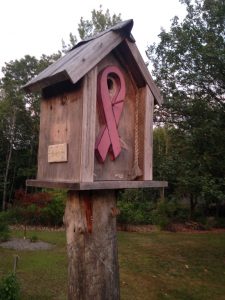 Whether you are an experienced gardener or novice, all volunteers are welcome. Individuals, families, civic organizations, senior citizen groups, and businesses are invited to volunteer at Ecotat. Our regular volunteer group sessions are Wednesdays 5:00 p.m. to dusk.
Whether you are an experienced gardener or novice, all volunteers are welcome. Individuals, families, civic organizations, senior citizen groups, and businesses are invited to volunteer at Ecotat. Our regular volunteer group sessions are Wednesdays 5:00 p.m. to dusk.
The legacy of Howard and Ruth Crosby must continue. We owe it to future generations to maintain the 91 acres of this beautiful piece of heaven known as Ecotat, which is a treasure that must be experienced in order to be appreciated. Visitors are sometimes seen taking prom, graduation or family photos in the garden. We invite you to visit the beautiful gardens from spring through fall and to snowshoe or ski the trails during the winter. The gardens are open daily for all to enjoy with no admission fee. Visitors’ parking is located at 25 Annis Road.
For more information, visit our website at Ecotat.org, Facebook, and GoFundMe. Donations are welcome and appreciated to help Ecotat pursue its mission to preserve and expand the gardens and trails for the enjoyment and use of future generations.
Food & Nutrition: Preserving Tomatillos
By Kathy Savoie, MS, RD, Associate Extension Professor, UMaine Cooperative Extension Cumberland County
Too many tomatillos (or green tomatoes) on hand? You may want to consider preserving one of my favorite green salsa recipes found below. Enjoy!
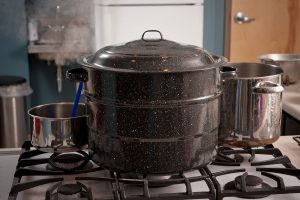
Tomatillo Green Salsa
- 5 cups chopped tomatillos
- 1-½ cups seeded, chopped long green chiles
- ½ cup seeded, finely chopped jalapeño peppers
- 4 cups chopped onions
- 1 cup bottled lemon or lime juice
- 6 cloves garlic, finely chopped
- 1 tablespoon ground cumin (optional)
- 3 tablespoons dried oregano leaves (optional)
- 1 tablespoon salt
- 1 teaspoon black pepper
Read more about Ingredients for Salsa Recipes.
Yield: About 5 pints
Please read Using Boiling Water Canners before beginning. If this is your first time canning, or for a refresher, it is recommended that you read Principles of Home Canning (PDF).
Procedure
Caution: Wear plastic or rubber gloves and do not touch your face while handling or cutting hot peppers. If you do not wear gloves, wash hands thoroughly with soap and water before touching your face or eyes.
Preparing Tomatillos: Remove the dry outer husks from tomatillos; wash thoroughly. They do not need to be peeled or seeded.
Preparing Peppers: The skin of long green chiles may be tough and can be removed by heating the peppers. Usually when peppers are finely chopped, they do not need to be skinned. If you choose to peel chiles, slit each pepper along the side to allow steam to escape. Peel using one of these two methods:
- Oven or broiler method to blister skins — Place chiles in a hot oven (400°F) or broiler for 6 to 8 minutes until skins blister.
- Range-top method to blister skins — Cover hot burner (either gas or electric) with heavy wire mesh. Place peppers on burner for several minutes until skins blister.
- To peel, after blistering skins, place peppers in a pan and cover with a damp cloth. (This will make peeling the peppers easier.) Cool several minutes; slip off skins. Discard seeds and chop.
The jalapeño peppers do not need to be peeled, but seeds are often removed.
Hot Pack: Combine all ingredients in a large saucepan and stir frequently over high heat until mixture begins to boil, then reduce heat and simmer for 20 minutes, stirring occasionally. Ladle hot into clean, hot pint jars, leaving ½-inch headspace. Remove air bubbles and adjust headspace if needed. Wipe rims of jars with a dampened, clean paper towel; apply two-piece metal canning lids. Process in a boiling water canner according to the recommendations in Table 1.
| Process Time at Altitudes of | ||||
|---|---|---|---|---|
| Style of Pack | Jar Size | 0 – 1,000 ft | 1,001 – 6,000 ft | Above 6,000 ft |
| Hot | Pints | 15 minutes | 20 minutes | 25 minutes |
Note: You may use green tomatoes in this recipe instead of tomatillos.
IMPORTANT:
The only other change you can safely make in this salsa recipe is to change the amount of spices and herbs. Do not alter the proportions of vegetables to acid and tomatoes because it might make the salsa unsafe. Do not substitute vinegar for the lemon juice.
Nutrition Information (Estimated values using Nutritionist Pro™ software)
Per 2 Tbsp: Calories 10, Total Fat 0 g, Sodium 89 mg, Fiber 0 g, Protein 0 g.
Daily Values: Vitamin A 1%, Vitamin C 17%, Calcium 1%, Iron 1%.
Percent Daily Values based on Dietary Reference Intakes.
From the “Complete Guide to Home Canning,” Agriculture Information Bulletin No. 539, USDA, revised 2015.
University of Maine Cooperative Extension’s Maine Home Garden News is designed to equip home gardeners with practical, timely information.
Let us know if you would like to be notified when new issues are posted. To receive e-mail notifications fill out our online form.
For more information or questions, contact Kate Garland at katherine.garland@maine.edu or 1.800.287.1485 (in Maine).
Visit our Archives to see past issues.
Maine Home Garden News was created in response to a continued increase in requests for information on gardening and includes timely and seasonal tips, as well as research-based articles on all aspects of gardening. Articles are written by UMaine Extension specialists, educators, and horticulture professionals, as well as Master Gardener Volunteers from around Maine, with Katherine Garland, UMaine Extension Horticulturalist in Penobscot County, serving as editor.
Information in this publication is provided purely for educational purposes. No responsibility is assumed for any problems associated with the use of products or services mentioned. No endorsement of products or companies is intended, nor is criticism of unnamed products or companies implied.
© 2018
Call 800.287.0274 (in Maine), or 207.581.3188, for information on publications and program offerings from University of Maine Cooperative Extension, or visit extension.umaine.edu.
